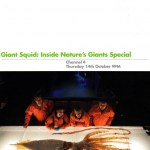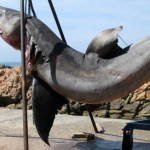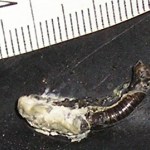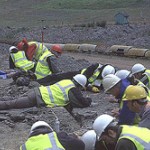shock horror the non-tetrapods are invading!
Once again I'm going to do the advertising thing for those fantastic Inside Nature's Giants people. Sorry that notice is so short, but I only received the relevant information today (Wednesday 13th October). Tomorrow sees the premiere screening (here in the UK, on Channel 4) of a 75 minute ING special on the giant squid.
And, yes, once again I'm breaking the 'tetrapods only' rule... for ING, however, I can make an exception. More info below the fold.
Thanks to Tom Mustill and others at Windfall Films. If you're on facebook be sure to 'like' Joy's page.
For previous Tet Zoo articles on ING,…
Earlier this year (in June), Channel 4 television here in the UK broadcast series 2 of Inside Nature's Giants (ING from hereon... titled Raw Anatomy in the US, you poor, poor people). You may have heard it here first. Hopefully you're familiar with ING series 1 - it looked at the anatomy of elephants, baleen whales, crocodiles and giraffes - and, if you're not, be sure to check out the Tet Zoo articles starting here. My praise for series 1 was extreme, by which I mean that I thought it was excellent: a real triumph and a major event in both the world of broadcasting, and in bringing good…
I don't want to get into the habit of advertising TV shows, but in this case I can make a definite exception. Thanks to the people at Windfall for sending what's known in the business as a TX card. For the Tet Zoo articles on series 1, see...
Inside Nature's Giants: a major television event worthy of praise and accolade. Part I!
Inside Nature's Giants part II: whale guts and hindlimbs ahoy
Enough mammals for the time being: crocodiles on Inside Nature's Giants (part III)
Inside Nature's Giants part IV: the incredible anatomy of the giraffe
Yes, I thought that birds didn't eat millipedes on account of their toxicity. Most millipedes (including the little species we have here in Britain) secrete noxious liquid through glands on their sides, and substances such as chlorine, iodine and cyanide are involved. As is obvious from the photo here, these chemicals don't make millipedes immune to attack from birds. After checking the literature I see that toads and hedgehogs also don't seem deterred by millipede toxins. However, other predators probably are, and toads and hedgehogs are actually unusual in being able to eat to tolerate…
The Bob Nicholls artwork I featured yesterday got some of you talking about a particularly famous denizen of the Jurassic seas. Namely, the gigantic, edentulous pachycormiform actinopterygian Leedsichthys problematicus from the Callovian Oxford Clay Formation. Hold on - - isn't that a... a... fish? How on earth can I justify this inexcusable off-topicness?
Well, quite easily actually. The gigantic size of Leedsichthys (more on that below) means that it can't be ignored whenever we discuss trophic interactions in the Middle Jurassic seas. Perhaps it was preyed on by the large,…




